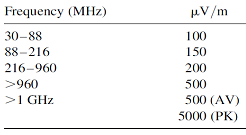a) In the United States, the Federal Communications Commission (FCC) is charged with the regulation of radio and wire communication (FCC part 15). It basically sets limits on the radiated and conducted emissions of a digital device.
i) The FCC further breaks the digital device class of products into Class A and Class B. Briefly detail the markets for which class A and class B products are marketed.
ii) Would you consider a network server to be a class A device, or class B device with regards to the regulatory tests that it must comply with? Why?
iii) Would you consider a $1000 high-speed laser printer a class A or class B digital device with regard to the regulatory tests it must comply with? Why?
b) The FCC radiated limits for class B Equipment, measured at 3m is given in table 1. Similarly, the CISPR 22 radiated emission limits for class B ITE equipment, measured at 10m, is given by table 2.
Table 1: FCC radiated emission limits for class B, measured at 3m.

Table 2: CISPR 22 Radiated emission limits for class B ITE equipment measured at 10m.

i) For all the frequencies listed in tables 1 and 2, provide the value of the limits in dBμV.
ii) Sketch a graph comparing the FCC Class B and the CISPR Class B radiated limits up to 1 GHz. Use dBμV values and assume a distance of 10 meters is taken as reference. List the range of frequencies for which the FCC is more stringent and the range of frequencies for which the CISPR is more stringent.